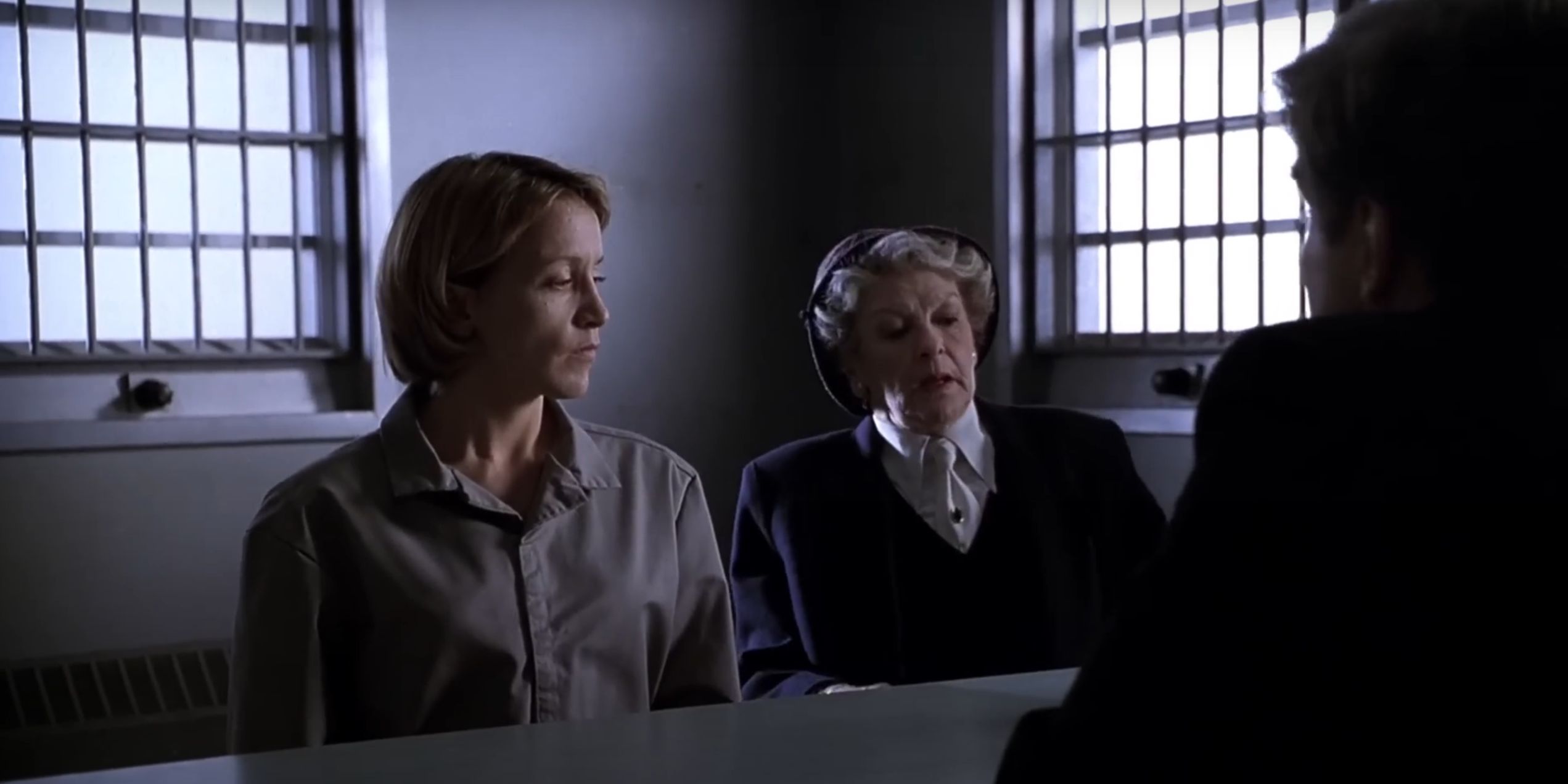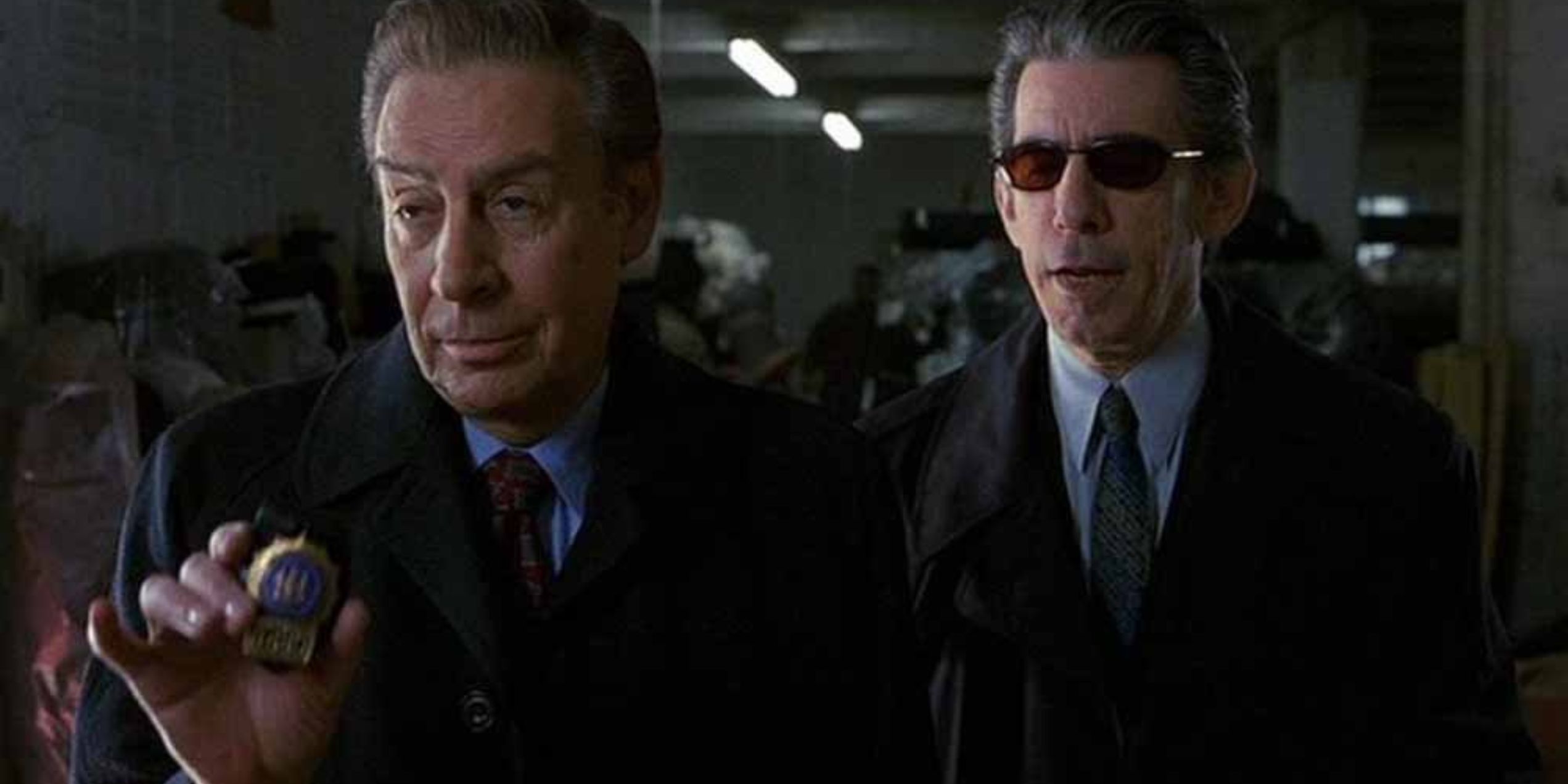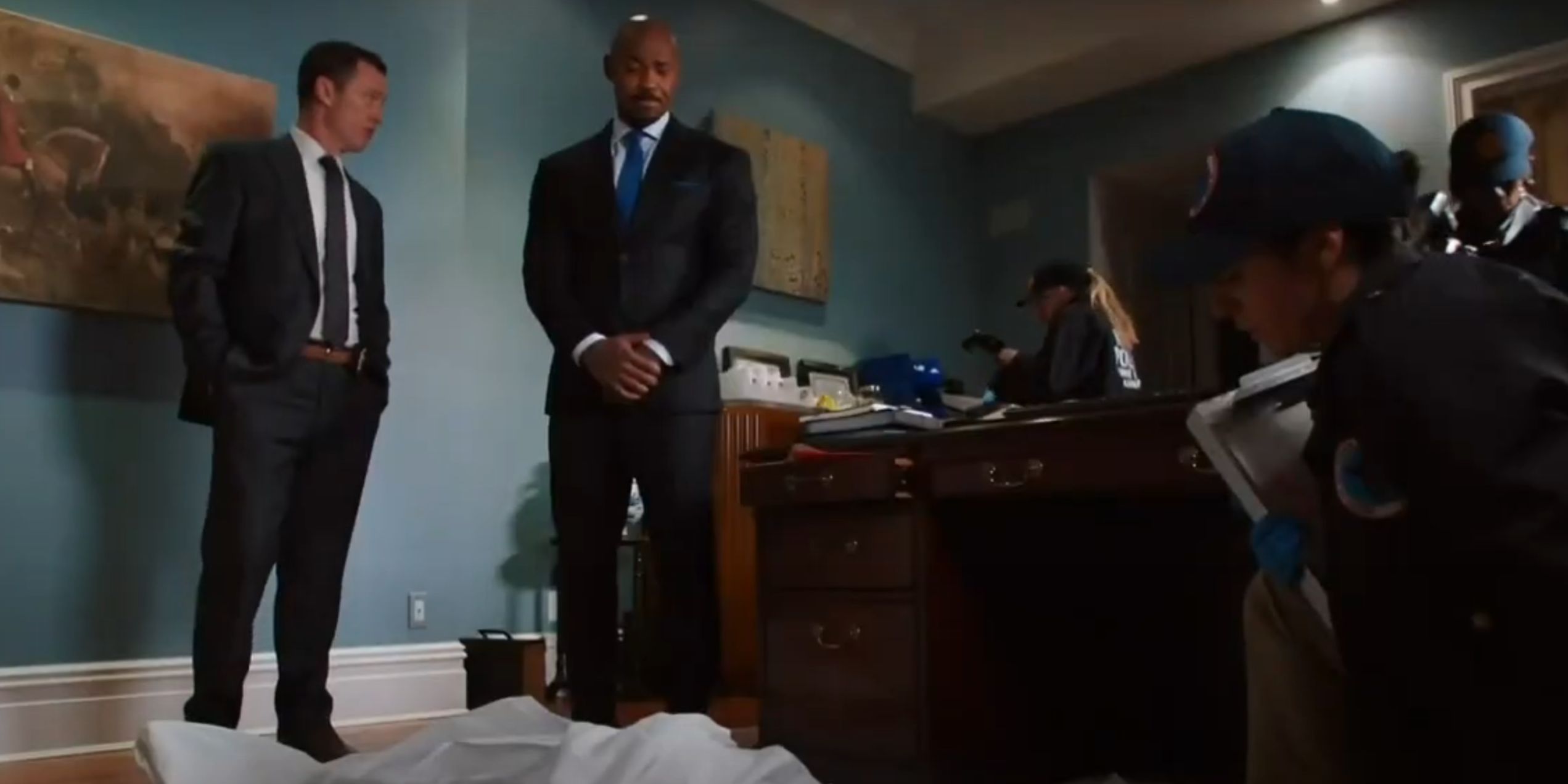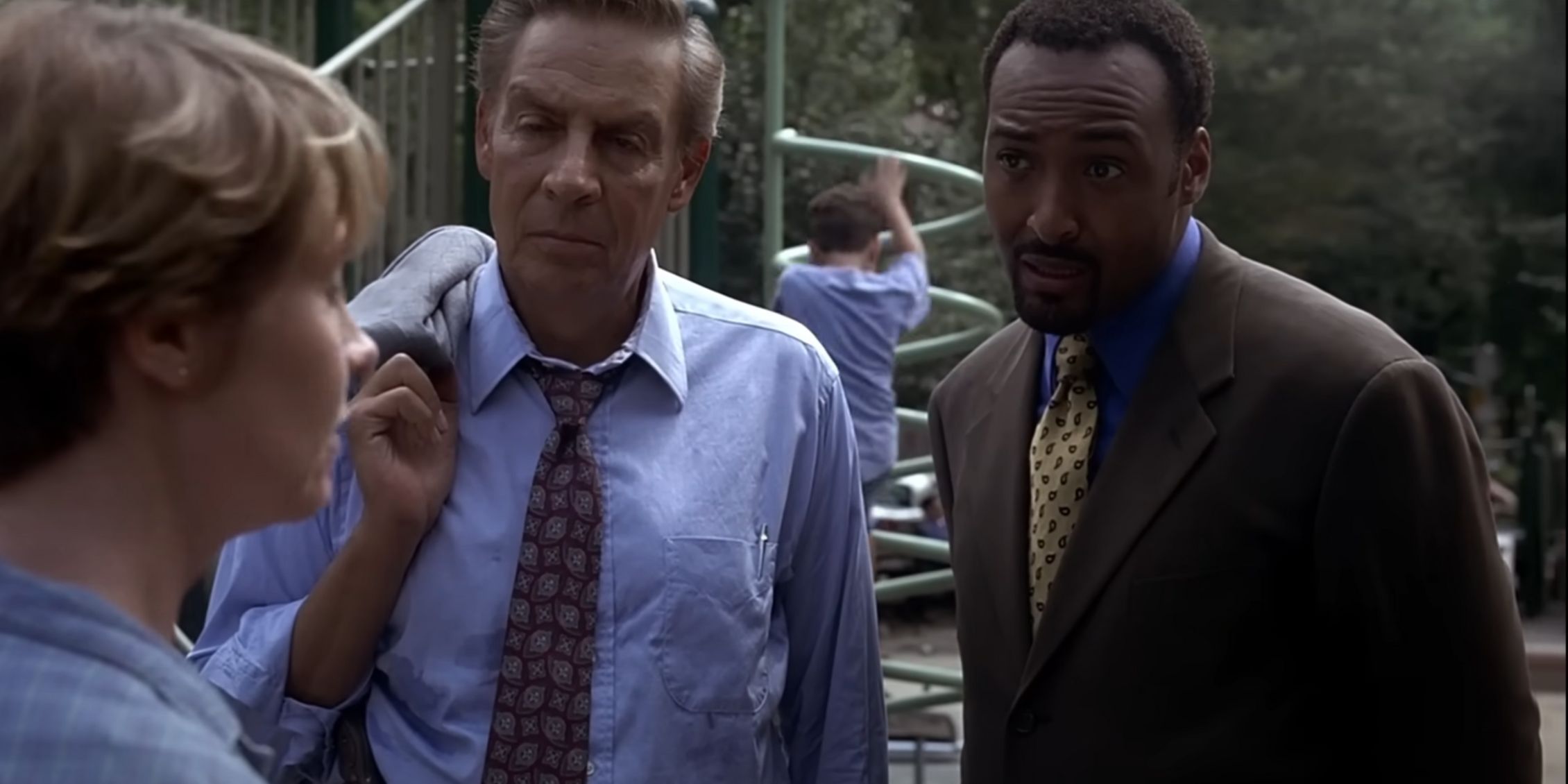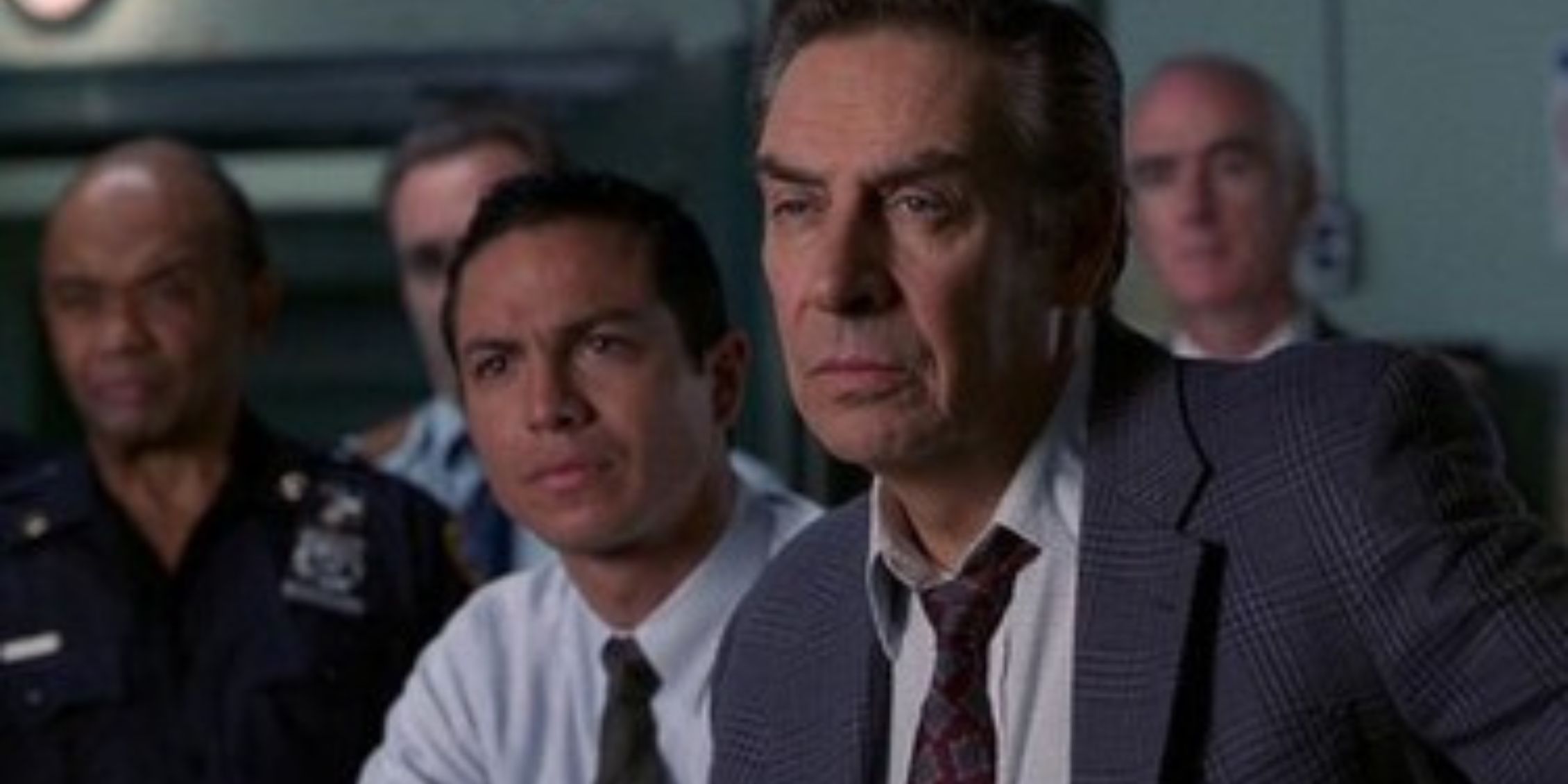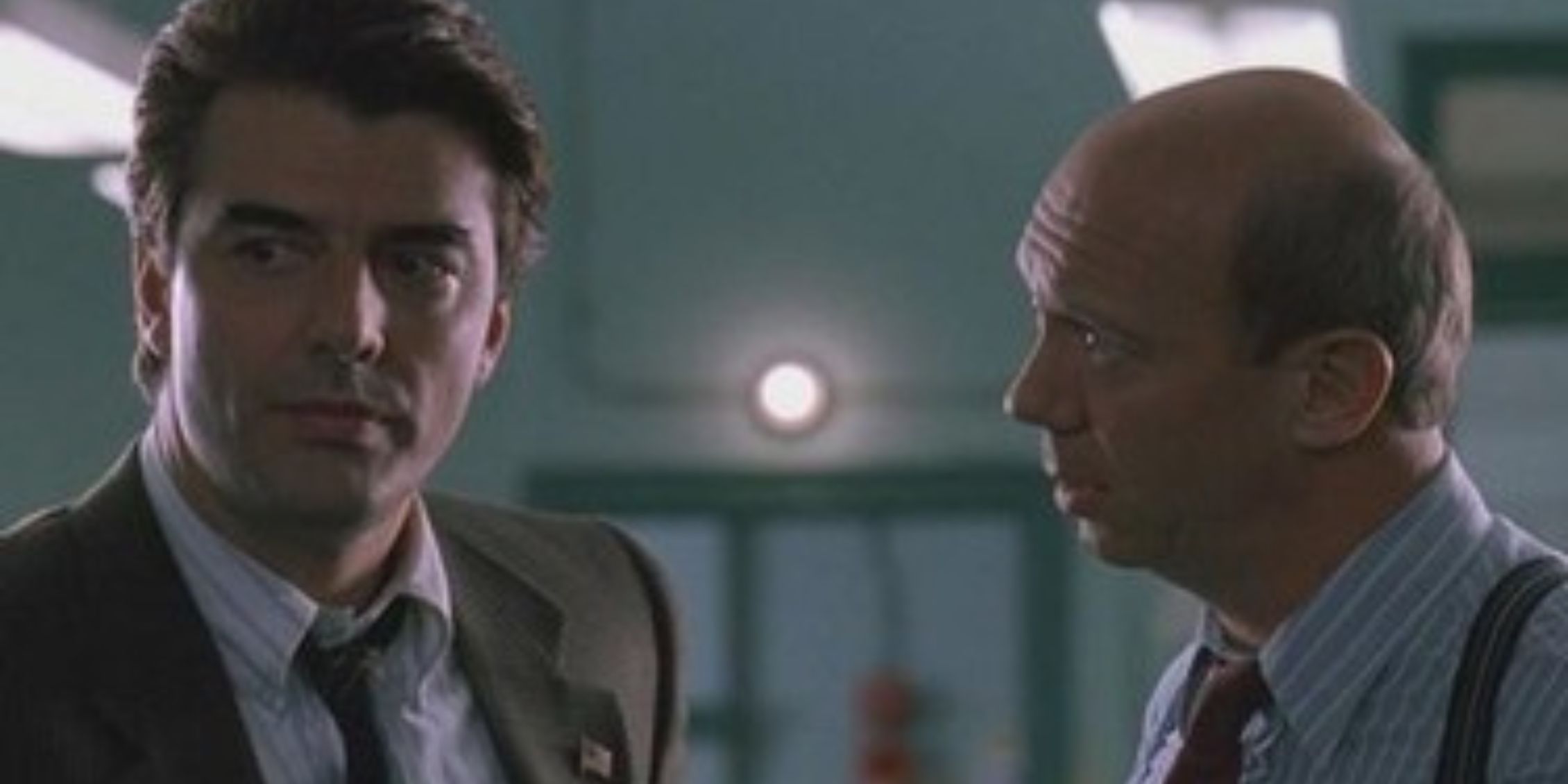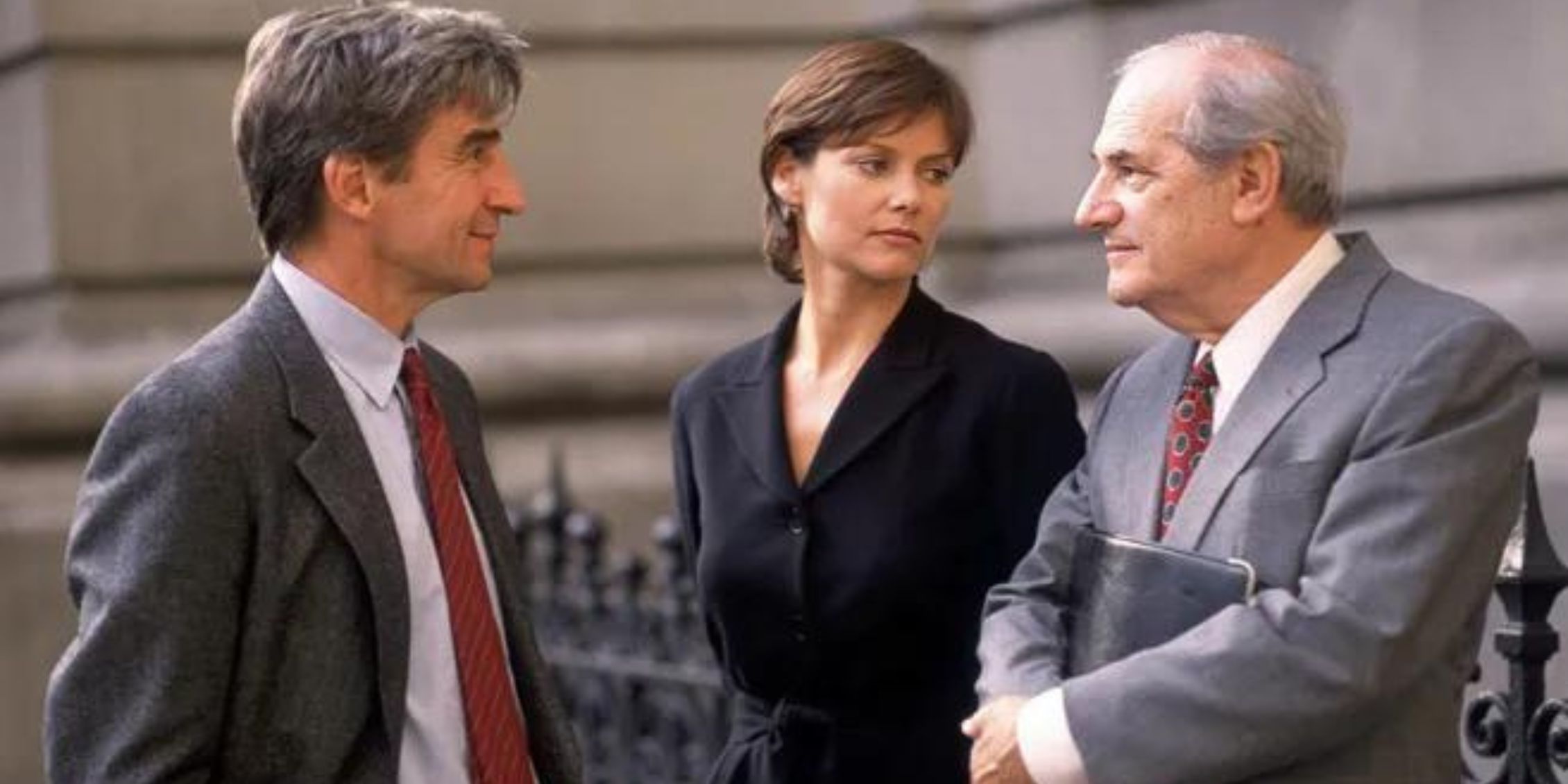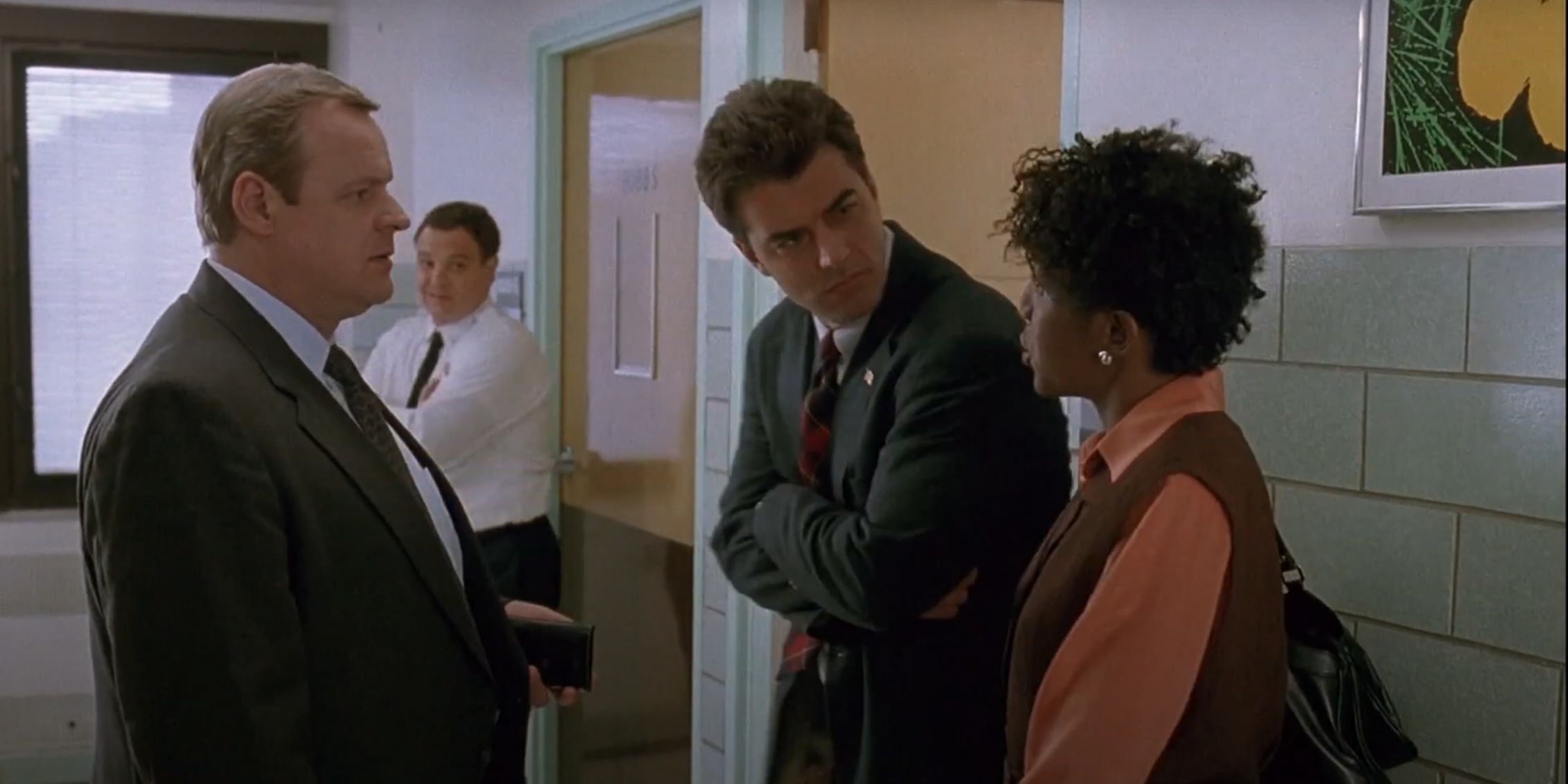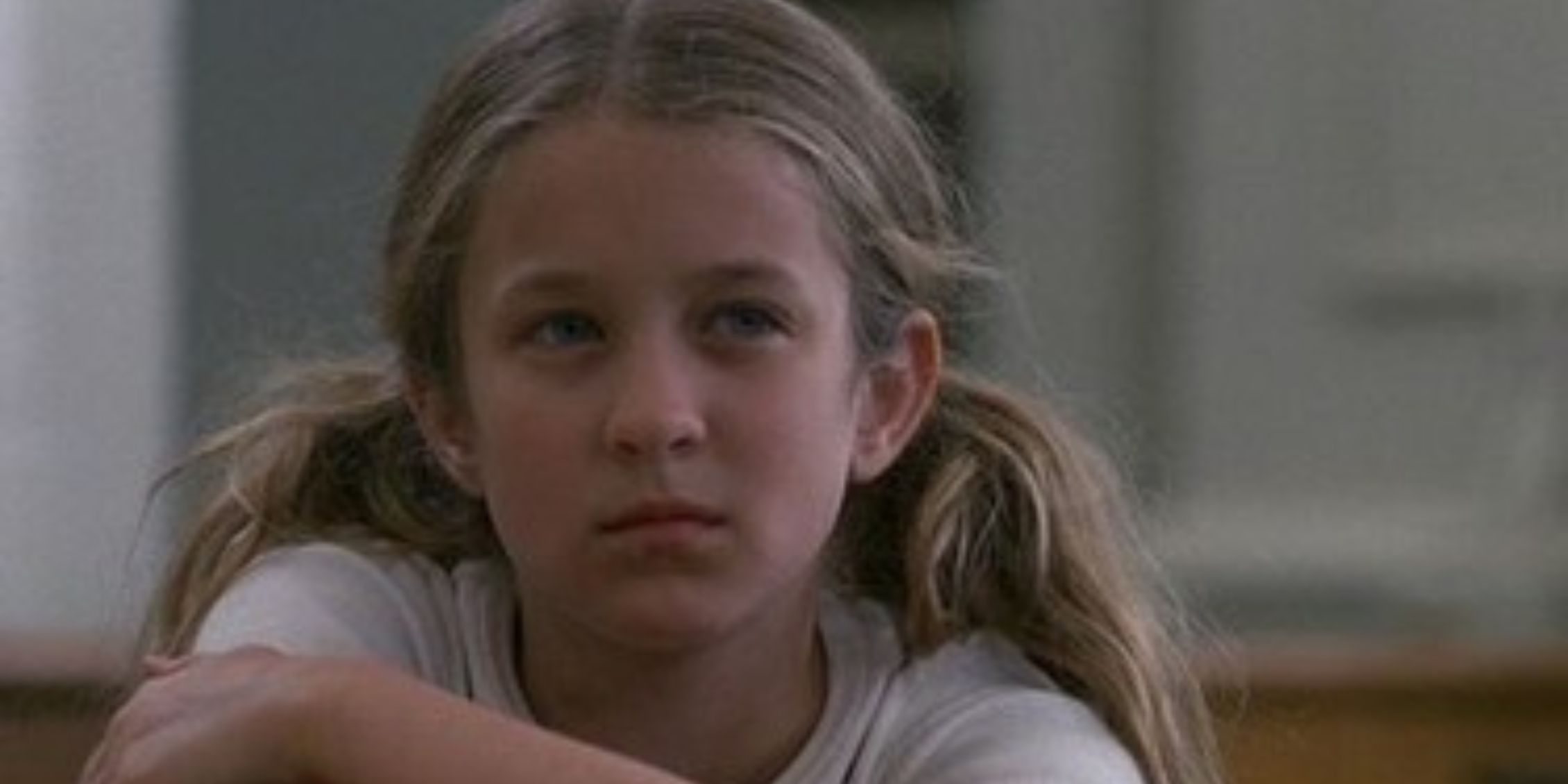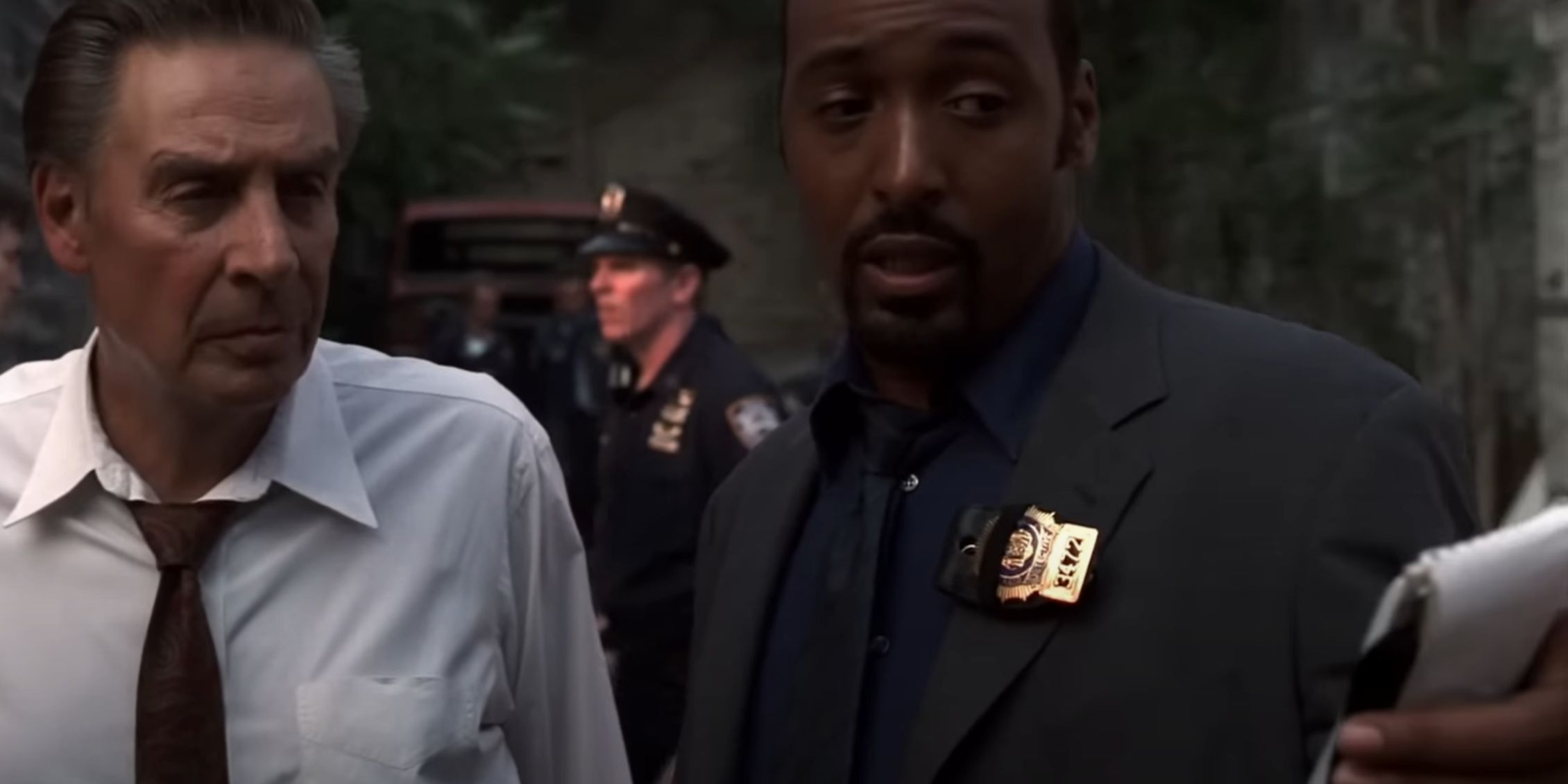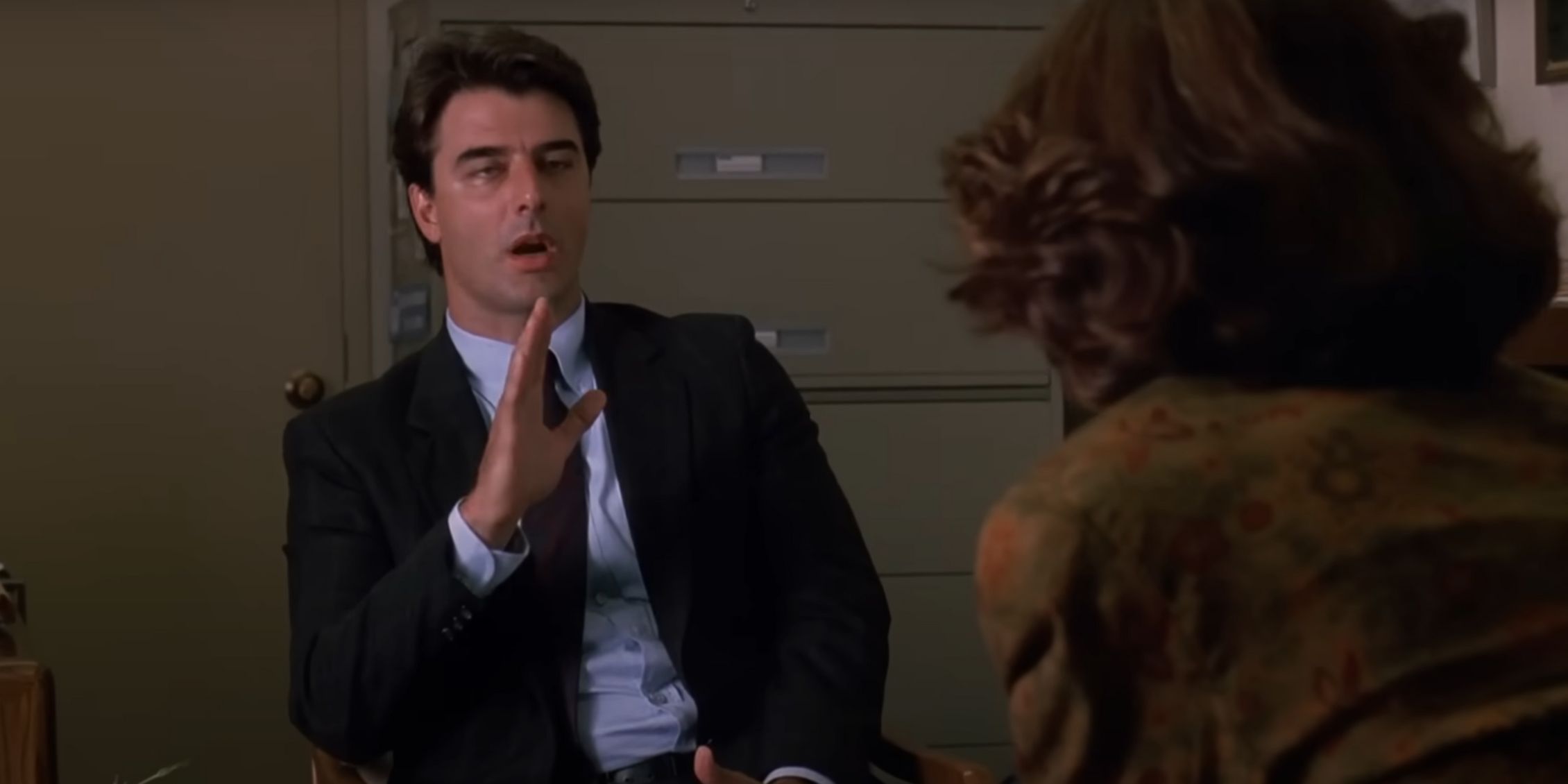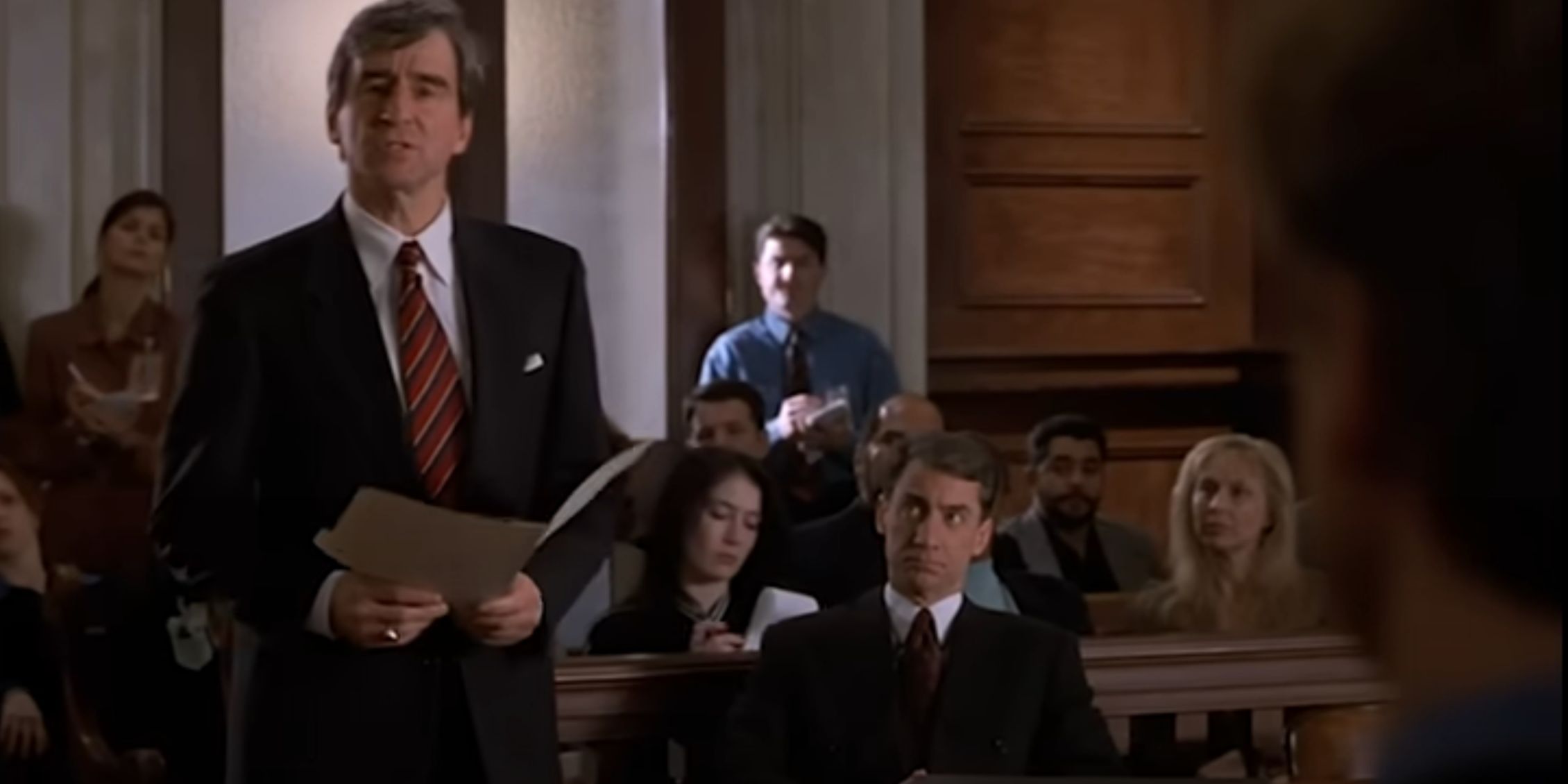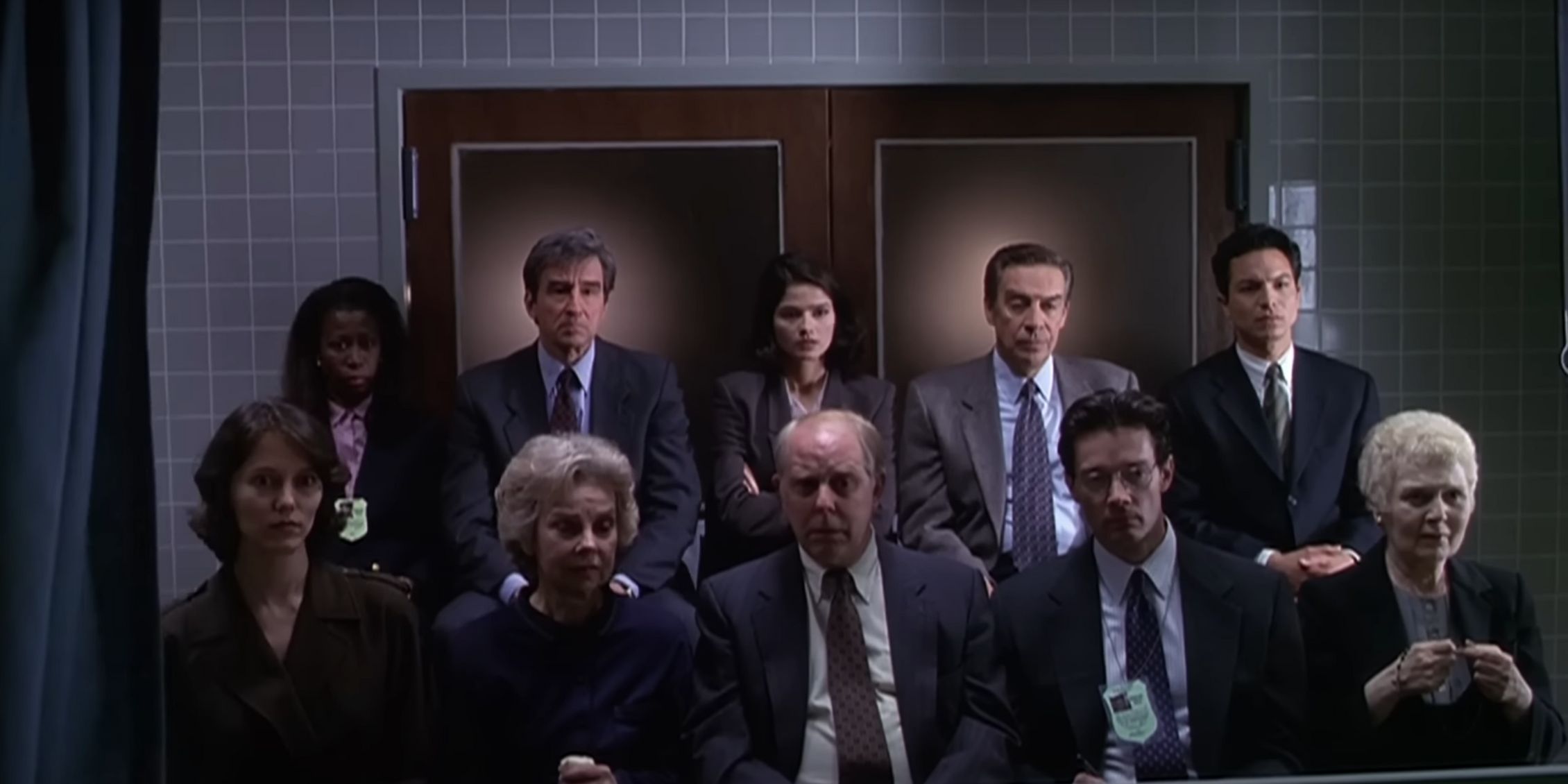This article contains mentions of murder and sexual assault.
After over two decades on television, the original Law & Order has many high-quality episodes, but some stand out more than others. When the long-running procedural began, the idea of dividing the show in half between the police and courtroom aspects of each case was novel and exciting. The series was so popular that it was brought back for a 21st season 10 years after its cancelation and Law & Order season 24 is on its way, proving the series is still going strong.
Law & Order is known for focusing on the case of the week rather than the characters’ personal lives. However, many of its most powerful episodes involve the cops and prosecutors grappling with personal issues, including character deaths. One of its most memorable episodes includes the death of Law & Order‘s Claire Kincaid, an assistant district attorney who later was revealed to have had a romantic relationship with the iconic Jack McCoy (Sam Waterston). The series also offered many powerful stories based on real-life cases, making it difficult to narrow down its extensive episode list to the all-time best.
15 Hot Pursuit
Season 6, Episode 5
Law & Order ripped one of the most infamous cases from the headlines for this season 6 story: the Patty Hearst case, which involved the daughter of newspaper mogul William Randolph Hearst getting kidnapped and later arrested for participating in bank robberies with her captors. The best Law & Order episodes take liberties with the source material so that it’s clear what it’s based on without being obvious. The episode achieved this by making the fictionalized version of Hearst a woman caught after a spree of robberies of local businesses, including one that leaves two people dead at a nightclub.
This story was also partially based on the case of Caril Ann Fugate, the youngest woman to ever be convicted of murder after she went on a killing spree with her boyfriend.
McCoy’s doubts about the woman’s claims that she had no choice lead him to charge her with murder, though not everyone agreed with him. The argument about this during court and in the DA’s office allowed the audience to make up their own minds about whether justice was done. The strong writing and acting, along with Amanda Peet playing the woman in question, is why it has earned a solid 7.9 rating on IMDB.
14 Working Mom
Season 7, Episode 14
Before becoming well-known for her role on Desperate Housewives, Felicity Huffman played a desperate prostitute on Law & Order. This episode is memorable not only for her performance but for the subject matter; Law & Order was one of the first shows to be willing to tackle police corruption rather than depict all police officers as heroic, and this story involved the murder of a retired police officer who was then accused of raping two sex workers.
Huffman’s character was a respected PTA mom who was also a sex worker, which helped change the image of sex workers as social deviants. Her claims that she was sexually assaulted and shot the cop to protect herself contribute to a powerful story that would have been one of Law & Order: SVU‘s best episodes instead of airing in the original series if the spinoff had existed then. Additionally, this story was so well-done that it was remade for Law & Order: UK. Thus, it deserves recognition despite only scoring a 7.6 average rating on IMDB.
13 Baby, It’s You
Season 8, Episode 6
Long before Homicide: Life On The Street‘s John Munch (Richard Belzer) transferred to the Special Victims Unit of the NYPD, he visited New York with the rest of his Baltimore unit in a two-part crossover episode with Law & Order. The episode involves a model found dead in New York, whose injuries suggest she was killed in Baltimore. This leads to a turf war over who gets the case; however, Munch and Briscoe (Jerry Orbach) strike up a friendship based on their mutual cynicism and history of failed marriages.
Orbach and Belzer’s chemistry makes them one of the best platonic duos on television.
While the premise is somewhat farfetched, it’s fun to watch the two units interact. Orbach and Belzer’s chemistry makes them one of the best platonic duos on television, and it’s a shame that the two didn’t get their own spinoff, but this episode is likely partially responsible for Belzer being invited to join the Law & Order: SVU cast. This story also scores high points for Pembleton’s (Andre Braugher) clashing with Jack McCoy (Sam Waterston) over his not-quite-legal methods of securing confessions, making its rating of only 7.7 on IMDB puzzling.
12 Private Lives
Season 22, Episode 19
Although the soft reboot of Law & Order has had many solid episodes, sometimes it is too forceful about what the “right” answer to social questions is. This isn’t the case in “Private Lives,” which revolves around the murder of a doctor who was giving gender-affirming care to transgender teenagers. Sasha Alexander is excellent as the victim’s wife, a right-wing politician who secretly supported her husband’s work with transgender youth but took the opposite stance publicly in order to ensure her election.
This character’s inclusion was a throwback to Law & Order‘s earlier days, as it presented a thorny question and allowed the audience to make up their own minds what the right answer was. The final scene was especially strong, with Alexander’s character justifying her seeming hypocrisy by explaining that if she lost her election bid, someone who was genuinely harmful to the transgender community would gain power. This made the issue less clear-cut and left the audience to grapple with the question of whether she was right, along with the issue of what care is appropriate for transgender teenagers.
11 Endurance
Season 11, Episode 1
“Endurance” loses points for revolving around a mother who might have killed her disabled child because she was overwhelmed, as it reinforces a negative and harmful idea about children with disabilities, especially autistic children, being a burden that drives parents to harm them. However, this problem is balanced by the fact that ultimately, the mother in this story is not responsible for the fire that killed her child. Additionally, this episode introduces Nora Lewin, the new DA taking Adam Schiff’s (Stephen Hill) place. These elements help it earn the solid 8.0 rating it has received from IMDB users.
This episode also includes a cameo from then-mayor Rudy Giuliani, who introduces Lewin.
10 Corruption
Season 7, Episode 5
This 1997 episode offered an interesting twist on the corrupt cop trope. Briscoe finds himself in hot water after a detective with ties to his past shoots a drug dealer, leading to the formation of a police commission on unethical police behavior. The detective tries to turn the tables, accusing Briscoe of covering up evidence, after Curtis refuses to say he saw the deceased reach for a gun, leading to a powerful conflict for McCoy, as he wants to prove this detective perjured himself and is corrupt despite the risk to his case if he does.
Amazingly, this episode was based on a real-life case in which heroin was continually stolen from the NYPD Department Property Clerk’s Office for years, though this is difficult to guess simply from watching. It’s a well-done story that puts Briscoe, who is one of Law & Order’s most iconic and beloved characters, in danger of losing his job and his freedom, thus earning its spot as one of the series’ all-time best episodes and its 8.3 rating on IMDB.
9 Manhood
Season 3, Episode 21
Technically, “Manhood” is guilty of the Bury Your Gays trope, which reinforces negative stereotypes by killing off gay characters, especially if they are about to find happiness. However, in this case, Law & Order was shining a light on homophobia in the police department at a time when few television shows were willing to address LGBTQ+ issues at all. The episode revolves around the death of a cop at a suspect’s hands after his calls for backup are ignored. The investigation shows that the cop was gay and that his fellow officers ignored his calls because of his sexual orientation.
This episode is strong even on rewatches. Stone prosecutes both the drug dealer who shot the cop and three officers who ignored his calls for backup, which is groundbreaking for the fictional New York justice system, considering how easily he could have ignored the cops’ failure to support their brother in blue. Sadly, the episode ends with the cops being acquitted, and it is debatable whether that underscores the homophobia and overreverence of cops or reinforces the idea that their stance was moral. However, the episode treats a sensitive subject fairly and deserves its 8.1 rating on IMDB.
8 Jeopardy
Season 6, Episode 4
In modern episodes, wealthy people attempting to buy themselves acquittals or immunity is a common theme across the Law & Order franchise. However, in the 1990s, it wasn’t as common, and “Jeopardy” was one of the first episodes to do so. This episode involves a judge who throws out all murder charges against a wealthy defendant accused of killing three people at a magazine office and takes the unusual step of a second investigation in the same episode.
Schiff’s internal conflict as he directs McCoy and Kincaid to investigate the judge elevate this far beyond standard
Law & Order
fare, making the episode’s 8.p0 rating on IMDB slightly low.
In most Law & Order episodes, the DA has only a small part, assigning cases and directing trial strategy to ensure a win. In this episode, however, Schiff is a major player, as the judge is a personal friend, but he suspects him of corruption. Schiff’s internal conflict as he directs McCoy and Kincaid to investigate the judge elevate this far beyond standard Law & Order fare, making the episode’s 8.p0 rating on IMDB slightly low.
7 Out Of The Half Light
Season 1, Episode 11
This early episode established Law & Order’s willingness to tackle tough subjects, as well as its brand of ripping stories from the headlines. The episode is based on the infamous Tawana Brawley case, in which a Black teenager accused four white men, including an ADA, of raping her, but a jury concluded she had fabricated the assault. Like Brawley, the girl in the Law & Order story was found with racial slurs written on her body, claimed four white men raped her, and was ultimately disbelieved.
In real life, the question of whether Brawley was lying or telling the truth has never been conclusively determined and many Black advocates believe she was the victim of biased reporting.
The Law & Order episode changes several details and uses the case to explore the question of how the powerful can manipulate the legal system. The victim’s family refuses to cooperate with the police and a powerful Black Congressman shields her in a former church, interfering with the investigation and causing Stone to question whether the assault happened at all. However, it’s equally possible that the family and the Congressman are trying to protect the girl from racial bias, and the audience is left to make up their own minds, making this one of the series’ most powerful episodes.
6 Killerz
Season 10, Episode 2
Law & Order explored the question of whether young children can be held responsible for murder in an episode involving a shockingly brutal case. When a child is found dead, with batteries stuffed in his mouth, the police suspect that one of his classmates, a ten-year-old girl named Jenny, is responsible. The violence, and the fact that a child is believed to be responsible, are frightening enough, but the episode shines because it doesn’t glamorize or sensationalize the event.
As the plot shifts from the question of getting enough evidence to arrest Jenny to the court case, the story moves into controversial territory, with the DA’s office and various mental health experts weighing in on whether Jenny is capable of understanding the severity of her actions and their foreseeable consequences. This meaty conflict makes this episode one of Sam Waterston’s best Law & Order episodes and earns it an 8.3 rating on IMDB.
5 The Ring
Season 13, Episode 5
After the 9-11 terrorist attack in 2001, every New York based television series felt obliged to address it in their stories. Law & Order waited a year in order to avoid sensationalizing the attack or retraumatizing survivors by using their plight for entertainment. “The Ring” gains high marks not only for sensitivity but for a story that is only tangentially related to 9-11, yet resonates emotionally and honors survivors.
This story involves a skeleton found a year after the attack. The remains are identified as someone who supposedly died in the World Trade Center that fateful day, but no one has ever been able to verify that she came to work. The story focuses on the possibility that someone killed her elsewhere and used 9-11 to get away with murder, addressing the issue of exploiting the tragedy for personal gain. The story is also enhanced by DA Branch’s personal connection to one of the suspects, making it difficult for him to prosecute the case without alienating powerful political allies.
4 C.O.D.
Season 14, Episode 24
Jerry Orbach was more closely associated with Law & Order than anyone else in the 1990s, despite not having been part of an original cast. Thus, his final episode was a tearjerker even though the story was mostly typical despite Briscoe’s decision to retire. The story is interesting, as it features two women who are tried separately for conspiring to murder each other’s husbands, forcing the two ADAs to try the cases at the same time.
It’s unusual for a Law & Order episode to feature two trials, but it is more meaningful that it is Orbach’s swan song. Orbach was supposed to join the short-lived Law & Order: Trial by Jury, but sadly passed away from prostate cancer after having filmed only two episodes. Thus, this final episode can be considered a fitting tribute to Orbach and his iconic character, who he is best known for playing today.
3 Confession
Season 2, Episode 1
The second season opener is one of Law & Order‘s saddest episodes, featuring the murder of original character Max Greevey (George Dzunda), who is gunned down in his driveway. It also foreshadows Logan’s (Chris Noth) eventual exit story, as Logan reacts to Greevey’s death with anger and violence, beating up a suspect to get a confession out of him.
This is one of the most impactful episodes of
Law & Order,
which is even more impressive considering it had only been on for a season when it was made.
The angry cop who can’t deal with grief has become somewhat of a tired trope, but it wasn’t so common in 1991, and the emotions in this episode are raw and relatable, even though modern audiences will likely be disgusted at Logan’s behavior. His reaction is coupled with the horrific fact that Greevey is killed outside his home, which is supposed to be a safe place. This is one of the most impactful episodes of Law & Order, which is even more impressive considering it had only been on for a season when it was made.
2 Under The Influence
Season 8, Episode 11
Sam Waterston appeared in Law & Order for over 20 years as Jack McCoy, and McCoy’s difficulty dealing with Claire Kincaid’s (Jill Hennessy) death was one of his strongest arcs. In “Under The Influence,” McCoy reacts emotionally to a case involving drunk drivers who were involved in a fatal hit-and-run, and it’s difficult for him to be objective because it reminds him of how Kincaid died, leading to one of the most emotional episodes in the series.
It was later revealed that McCoy and Kincaid had been lovers.
This episode is also one of the few to feature Jamie Ross in a compelling role as the Assistant District Attorney. Ross confronts McCoy during this episode, believing he is allowing his emotions to get the better of him, which adds to the episode’s appeal. Ross ends up resigning at the end of the episode, and McCoy faces an ethics inquiry for the way he conducted the case, making this one of the few times that McCoy’s career is in danger throughout the series.
1 Aftershock
Season 6, Episode 23
“Aftershock” is the only episode of Law & Order that doesn’t follow the format of the detectives being called into a murder investigation and the lawyers handling the court case. Instead, this episode involves the lawyers and cops witnessing the execution of a man they arrested and convicted. The event takes a significant toll on each of the characters, and they struggle with their emotions after watching the man die.
At the time this episode was filmed, New York had not executed anyone in 50 years.
This emotional episode is memorable not only for each character’s emotional arc, but for its shocking ending. Kincaid had been considering resigning from her position because of her upset over the execution, but she suffered a worse, and unexpected fate: in the last minute of the episode, while driving Briscoe home, she was killed when a drunk driver hit her car. The shock of her death would be explored in future episodes of Law & Order, and there was also an ironic component to it because she had been driving Briscoe home since he was too inebriated to drive safely.
